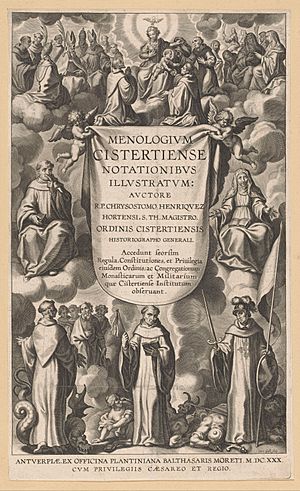Crisóstomo Henríquez facts for kids
Crisóstomo Henríquez (born in 1594, died in 1632) was a Spanish Cistercian monk and historian. He belonged to a Spanish group of Cistercian monks. He spent much of his life working in the Spanish Netherlands, which is now part of Belgium. He is known for writing many books about the history of his religious order.
Contents
About Crisóstomo Henríquez
His Early Life and Studies
Crisóstomo Henríquez was born in Madrid, Spain, in 1594. When he was 13, he joined the Cistercian Abbey of Huerta in Spain. This is where he became a monk.
His teachers then sent him to different monasteries. There, he studied important subjects like philosophy and theology. Even while he was still a student, he showed a great interest in history. He even published his first book, the History of the Monastery of Meyra, at this time.
Moving to Flanders
After finishing his studies, Crisóstomo returned to Huerta. Meanwhile, his parents had moved to Flanders (now part of Belgium). They lived at the court of Archduke Albert, who governed Flanders.
His parents asked the Archduke to request that Crisóstomo be sent to Flanders. The head of the Cistercian order in Spain agreed. So, Crisóstomo left Spain and never returned.
Once in Flanders, his leaders asked him to write the history of the Cistercian Order. To do this, he visited many monasteries in Belgium. He went to places like Aulne, Villers, and Our Lady of the Dunes Abbey. These were some of the most important monasteries in Europe at the time. He looked through their libraries and old records. Everyone was happy to help him because he was so friendly.
His Death
Crisóstomo Henríquez died on December 23, 1632. He passed away in Louvain, which is still home to a leading Catholic university.
His Reputation and Honors
Crisóstomo Henríquez was seen as a great example of a monk. People admired his knowledge and his humble nature. He always followed the rules and respected his leaders. His friendly personality made everyone like him.
His leaders gave him many honors and important titles. He became the official historian for the Spanish Cistercian group. Later, he was made a Vicar General and then the Grand Prior of the Military Order of Calatrava.
His Writings
From 1619 to 1632, Crisóstomo Henríquez published over 40 books. He wrote in Dutch, Latin, and Spanish. Here are some of his most important works:
- Thesaurus Evangelicus vel Relatio Illustrium Virorum Ordinis Cisterciensis in Hibernia: This was one of his first books. It was about famous Cistercian monks from Ireland.
- Sol Cisterciensis in Belgio: This book told the stories of important men from the Abbey of Villers. It focused on their good deeds and miracles.
- Fasciculus SS. O. C.: In this work, he wrote about the lives of important Cistercian figures. These included leaders, abbots, and martyrs (people who died for their faith). He also wrote about the start of military orders.
- Coronae Sacrae O. C.: This book, meaning "Sacred Crowns of the Cistercian Order," was about queens and princesses. It told the stories of those who left their royal lives to become Cistercian nuns.
- Bernardus Immaculatus: In this book, he explained the ideas of St. Bernard of Clairvaux. It covered topics like the Immaculate Conception of Mary.
- Phoenix Reviviscens: This book, meaning "Resurging Phoenix," gave information about old Cistercian writers in England. It also included a short story about his own life.
- Menologium Cisterciense: This was his most important work. The first part of the book shared the lives of Cistercians known for their holiness. The second part included the rules and history of the order. He also helped create engraved portraits of many important Cistercian members for this book.
His books were written in a clear and elegant style. They showed that he had deep knowledge. However, some people did criticize his work. Claude Chalemot, another historian, said that Crisóstomo sometimes left out important saints. He also said that some people included in his Menology did not belong there. Another problem was that he did not always give exact dates.
Sources
![]() This article incorporates text from a publication now in the public domain: "article name needed". Catholic Encyclopedia. (1913). New York: Robert Appleton.
This article incorporates text from a publication now in the public domain: "article name needed". Catholic Encyclopedia. (1913). New York: Robert Appleton.
See also
 In Spanish: Crisóstomo Henríquez para niños
In Spanish: Crisóstomo Henríquez para niños


